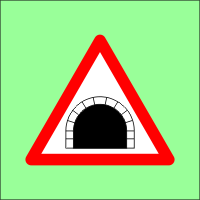Tunnels
There are wide tunnels, narrow tunnels and low tunnels all requiring different attention. Just like bridges and narrow sections they represent a hazard where you might come into conflict with other boats.
Signs should tell you whether it is possible to pass another boat coming in the opposite direction safely in the tunnel. The many waterway guides are also useful for this information.
If you do meet another boat then slow down to engine tick over well before you meet. If you do touch either the other boat or the side of the tunnel the damage will be much reduced at low speed.
Tunnels can be quite threatening for the novice as they do their best to steer down what appears to be a very narrow, (even seemingly impossible), gap between the tunnel side and an oncoming boat. It isn't helped when they cannot see anything in front because they are being blinded by the headlight of the approaching boat.
Considerate Boaters use headlights with just enough power to see their way through tunnels and avoid fitting a million candlepower lamp which will melt the paint of an oncoming boat. Considerate Boaters also angle their headlights up and to the right so they get a good view of tunnel side and reduce the forward glare.
Use the same rules as for Meeting Boats but slow down to engine tick over and slow down early so you can use a little power to give better steering when you are very close to the other boat.
If you are steering a steel hulled boat through a tunnel then give special consideration when meeting a less substantial hulled boat such as a fibreglass cruiser.
Avoid entering a tunnel, (which is wide enough for boats to pass), if an oncoming boat is close to your end. It doesn't make sense to force a passing manoeuvre 200 foot inside the tunnel just to save a few seconds and it may even save a collision.
Keep clear of the boat ahead of you and don't even think of overtaking no matter how slow they might be going.